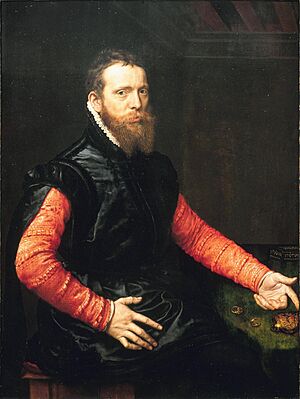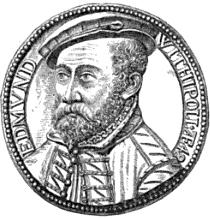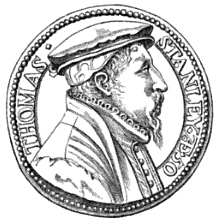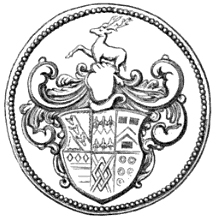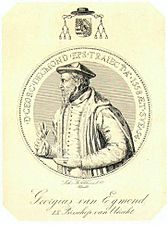Steven van Herwijck facts for kids
Steven Cornelisz. van Herwijck was a talented artist from Utrecht, a city in the Netherlands. Born around 1530, he was a sculptor and a special kind of artist called a gem engraver. This means he carved tiny pictures and designs into precious stones or made small metal artworks called medallions and medals. He was especially known for his portrait medals, which were like small, round pictures of people's faces. Steven spent two periods of his life working in England, where he eventually passed away around 1565 or 1567.
Contents
Life of Steven van Herwijck
Steven van Herwijck worked in Italy in 1557. He returned to Utrecht in 1558. There, he became a Master in the artists' group, which was actually shared with saddlemakers at the time! His earliest medals that we still have today are from this year. They show George van Egmond, who was a Bishop, and Engelken Tols.
In 1559, Steven moved to Antwerp. Nine of his medals from this time still exist, including a portrait of Jacobus Fabius. Because of problems related to religion, he moved to Poland in 1561. There, he created medallions of King Sigismund II and other members of the Polish royal family.
In 1562, Steven traveled to England. He made the first portrait medals of regular people ever created in that country. These medals showed important figures like William Parr, 1st Marquess of Northampton and his wife Elizabeth Brooke. He also made medals of William Herbert, 1st Earl of Pembroke (1501–1570), Anne Heneage, Thomas Stanley, and Richard Martin, who was the Lord Mayor of London, and his wife Dorcas. Other notable people he made medals for included Edmund Withypoll and Maria Dimock.
By 1564, van Herwijck was back in the Netherlands. He spent time in both Utrecht and Antwerp. A painting by Antonis Mor, called Portrait of a Goldsmith, is thought to be of van Herwijck and is dated 1564. It's likely that a portrait medallion of Mor, made by van Herwijck, is from this same period. The portrait by Mor might even celebrate van Herwijck's marriage. A portrait of his wife, Jonekin, also by Mor and from the same year, is in a museum in Glasgow.
Steven van Herwijck returned to London in 1565. While there, he created a medal of Queen Elizabeth. The only known example of this medal was found in a field in 1962. It is now in the National Portrait Gallery in London. His medallion of the French ambassador Michel de Castelnau is also from 1565. Steven van Herwijck died in London sometime before Easter in 1567. He left behind his wife, Jonekin, and his children.
Identifying Steven van Herwijck
Stephen of Holland
Van Herwijck's medals usually have his initials "Ste. H." or "Ste. H. F." on them. In the 1700s, an English artist named George Vertue thought these initials meant "Stephen of Holland made this" (which in Latin would be Stephanus Hollandus fecit). Later, in 1922, a researcher named Victor Tourneur proved that the artist "Ste H." was indeed Steven van Herwijck, who was born in Utrecht around 1530.
"The famous paynter Steven" ?
In 1590, a list of paintings owned by John Lumley, 1st Baron Lumley mentioned several artworks from the early 1560s by "the famous paynter Steven." For a long time, people thought this "Steven" was another Flemish artist named Steven van der Meulen.
However, in 2009, a new idea came up. A researcher suggested that the painter "Steven" might actually be van Herwijck. Some art museums, like Tate Britain, even started to agree with this new idea. They showed a portrait of Queen Elizabeth I and said it was likely painted by van Herwijck.
But not everyone agrees. Some experts, like Elizabeth Goldring and Edward Town, have raised doubts. They point out that some events fit better with what we know about Steven van der Meulen's life than with van Herwijck's. For example, a painting of John Lumley in the National Portrait Gallery was made in the 1570s or 1580s. Both van der Meulen and van Herwijck had already died by then. So, the artist who painted it is still a mystery!
Works
-
Thomas Stanley (front side), 1562
-
Thomas Stanley (back side), with his coat of arms, 1562


